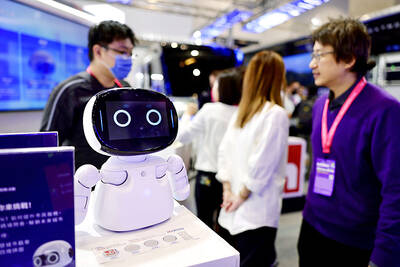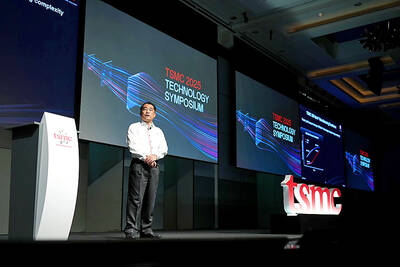Nokia said yesterday it expects global market share in the third quarter to be lower than in the second quarter because of aggressive pricing by competitors. Its share price tumbled 11 percent.
The world’s top handset maker gave no figures, but in July had predicted “its mobile device market share in the third quarter 2008 to be approximately at the same level sequentially” as during the second quarter.
In April through June, Nokia sold 122 million phones — with a global market share of 40 percent.
The company’s shares yesterday plunged 11 percent to 13.97 euros (US$20.24) on the Helsinki Stock Exchange.
Nokia said the reason for an expected fall in market share included “Nokia’s tactical decision to not meet certain aggressive pricing of some competitors.”
It also said it was hit by “the overall market competition, including the entry markets, and the temporary impact of a slower ramp-up of a mid-range Nokia device.”
The company said it would continue to be guided by a policy that is “sustainably profitable in the longer term.”
But it was upbeat about the rest of the year, saying it will continue to target an increase in “its market share in mobile devices for the full year 2008.”
It gave no figures.
Nokia said that although economic gloom would also affect global phone sales, it “continues to expect industry mobile device volumes in 2008 to grow 10 percent or more from the approximately 1.14 billion units Nokia estimated for 2007.”
Although Nokia has reached its long-stated goal of 40 percent market share, it has vouched to continue to aim for higher growth.
But the company’s share price has plunged about 40 percent this year amid concerns the mobile industry would suffer as the credit crunch and inflation take their toll on economic growth and consumers’ spending power.
Also, the closely watched average selling price of Nokia handsets has continued to fall because of higher volumes of cheaper phones sold in emerging markets and a negative impact of the weak dollar.
In the second quarter, the average price for a Nokia phone was 74 euros, down from 79 euros in the first quarter of the year and 90 euros in the second quarter of last year.
Chief financial officer Rick Simonson told The Associated Press in July that more than half of the 122 million Nokia handsets sold in the quarter were low-end phones with an average selling price of US$80 or less.
Simonson also said that cellphones had become such an everyday item in people’s lives that he predicted a 10 percent growth worldwide “with half a year visibility.”
Nokia is due to report its third-quarter 2008 results on Oct. 16.
Last year, Nokia sold nearly 440 million handsets, accounting for 40 percent of all global cellphone sales. It is based in Espoo near the Finnish capital and employs 116,000 people worldwide.

DEMOGRAPHICS: Robotics is the most promising answer to looming labor woes, the long-term care system and national contingency response, an official said Taiwan is to launch a five-year plan to boost the robotics industry in a bid to address labor shortages stemming from a declining and aging population, the Executive Yuan said yesterday. The government approved the initiative, dubbed the Smart Robotics Industry Promotion Plan, via executive order, senior officials told a post-Cabinet meeting news conference in Taipei. Taiwan’s population decline would strain the economy and the nation’s ability to care for vulnerable and elderly people, said Peter Hong (洪樂文), who heads the National Science and Technology Council’s (NSTC) Department of Engineering and Technologies. Projections show that the proportion of Taiwanese 65 or older would

Nvidia Corp yesterday unveiled its new high-speed interconnect technology, NVLink Fusion, with Taiwanese application-specific IC (ASIC) designers Alchip Technologies Ltd (世芯) and MediaTek Inc (聯發科) among the first to adopt the technology to help build semi-custom artificial intelligence (AI) infrastructure for hyperscalers. Nvidia has opened its technology to outside users, as hyperscalers and cloud service providers are building their own cost-effective AI chips, or accelerators, used in AI servers by leveraging ASIC firms’ designing capabilities to reduce their dependence on Nvidia. Previously, NVLink technology was only available for Nvidia’s own AI platform. “NVLink Fusion opens Nvidia’s AI platform and rich ecosystem for

Taiwan Semiconductor Manufacturing Co (TSMC, 台積電) yesterday said it is building nine new advanced wafer manufacturing and packaging factories this year, accelerating its expansion amid strong demand for high-performance computing (HPC) and artificial intelligence (AI) applications. The chipmaker built on average five factories per year from 2021 to last year and three from 2017 to 2020, TSMC vice president of advanced technology and mask engineering T.S. Chang (張宗生) said at the company’s annual technology symposium in Hsinchu City. “We are quickening our pace even faster in 2025. We plan to build nine new factories, including eight wafer fabrication plants and one advanced

‘WORLD’S LOSS’: Taiwan’s exclusion robs the world of the benefits it could get from one of the foremost practitioners of disease prevention and public health, Minister Chiu said Taiwan should be allowed to join the World Health Assembly (WHA) as an irreplaceable contributor to global health and disease prevention efforts, Minister of Foreign Affairs Lin Chia-lung (林佳龍) said yesterday. He made the comment at a news conference in Taipei, hours before a Taiwanese delegation was to depart for Geneva, Switzerland, seeking to meet with foreign representatives for a bilateral meeting on the sidelines of the WHA, the WHO’s annual decisionmaking meeting, which would be held from Monday next week to May 27. As of yesterday, Taiwan had yet to receive an invitation. Taiwan has much to offer to the international community’s